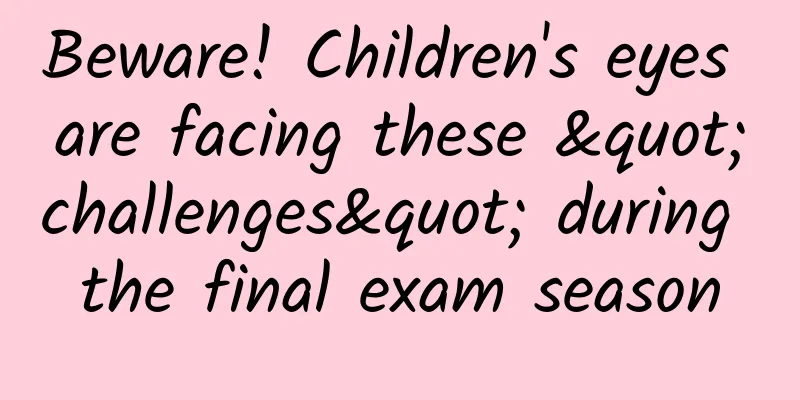Beware! Children's eyes are facing these "challenges" during the final exam season

|
"My child has been reviewing for the final exams recently. Will his eyesight worsen faster by doing exercises all the time?" With the final exams approaching, the children are racing against time to review their lessons and do exercises. However, during this critical period, the children's eyes are indeed facing many severe "challenges" that require us to be highly vigilant. Challenge 1: Risk of decreased visual function Doing exercises for a long time will keep the child's eyes in a state of tension, just like a spring that is always taut, which can easily lead to poor visual function. For example, the eye's ability to adjust will decrease. Under normal circumstances, the eyes can easily see objects at different distances, but after excessive use of the eyes, distant objects may become blurry, and it will be difficult to see nearby objects after a long time. This is because the ciliary muscles in the eyes are in a state of contraction for a long time, just like a rubber band that has been stretched taut has lost its elasticity, and cannot adjust the thickness of the lens in a timely and accurate manner, thus affecting vision. Moreover, excessive use of the eyes may also lead to a deterioration in the ability of the two eyes to work together, resulting in double vision, ghosting and other phenomena, affecting children's learning efficiency and visual quality. Challenge 2: Rapid increase in myopia For children who already have myopia, the final exam season is an even more dangerous period, because excessive use of the eyes will further lengthen the eye axis, causing myopia to increase faster. The eye axis is like the "height" of the eyeball. Under normal circumstances, it will gradually increase with the development of the body, but excessive use of the eyes will accelerate this process, causing the shape of the eyeball to change, and the light will focus farther in front of the retina, and the degree of myopia will deepen accordingly. Long-term close-up use of the eyes is one of the main reasons for the rapid increase in myopia. If you don't pay attention to it during this period, your child's myopia may increase significantly in a short period of time, which will not only bring inconvenience to the child's life, but also increase the risk of other eye diseases in the future. Image source: Pixabay Challenge 3: Potential threat of eye diseases In addition to the decline in visual function and the rapid increase in degree, excessive use of eyes when doing exercises may also cause some eye diseases. Staring at books or electronic screens for a long time, the eyes cannot get enough rest, which can easily lead to uncomfortable symptoms such as dry eyes, redness, swelling, and pain. This may be caused by eye inflammation such as dry eyes or conjunctivitis. If children often rub their eyes, blink frequently, and have increased eye secretions after doing exercises, parents must pay attention and take their children to the hospital for examination in time. In addition, excessive use of eyes may also increase intraocular pressure and increase the risk of glaucoma. Although this situation is relatively rare in children, it should not be ignored. Key points: The importance of regular vision checks Given the challenges that children's eyes face during the final exam season, it is particularly important to take your child to the hospital for a regular vision check. Through professional vision examinations, doctors can keep abreast of changes in your child's vision and eye health, such as whether there is decreased vision, increased degrees, eye diseases, and other problems. If problems are found, appropriate treatment and intervention measures can be taken as early as possible to prevent the problem from worsening. For example, if a child's degree increases rapidly, the doctor can adjust the degree of the glasses according to the specific situation or recommend measures such as wearing orthokeratology lenses to control the development of myopia; if eye diseases are found, they can also be treated in time to prevent the condition from worsening. Image source: Pixabay Parents should guide their children to arrange their review time properly and avoid doing long hours of continuous practice. After every 30-40 minutes of study, they should let their eyes rest for 10-15 minutes. They can look into the distance, close their eyes and rest, or do some simple eye exercises. At the same time, they should also pay attention to their children's learning environment, ensure that the light is sufficient and even, and avoid studying in an environment that is too bright or too dark. Source: Chongqing Aier Children's Eye Hospital Co., Ltd. Audit expert: Wang Jiale Statement: Except for original content and special notes, some pictures are from the Internet. They are not for commercial purposes and are only used as popular science materials. The copyright belongs to the original authors. If there is any infringement, please contact us to delete them. |
<<: Viral myocarditis: understanding, prevention and response
Recommend
Is hcg dilution the same as hcg value?
In clinical tests, in order to determine whether ...
What are the reasons for maternal arm pain
Many mothers experience arm pain, which can be ha...
Painful urination after uterine curettage
Induced labor and abortion are both ways to end a...
Will irregular menstruation affect fertility?
Many female friends have irregular menstruation, ...
No withdrawal bleeding with emergency contraceptive pills
Withdrawal bleeding is a relatively common sympto...
Is it normal to have a lot of white discharge after sex?
Marriage is the beginning of happy sexual interco...
Reasons for sudden pregnancy after years of infertility
Every family is looking forward to the arrival of...
Traditional Chinese medicine prescription for maintaining the uterus
We know that Chinese medicine can better treat di...
Can I wash my butt during menstruation?
You can wash your butt during menstruation, which...
What causes high testosterone in women?
High testosterone levels in women are caused by h...
Is the habit of “rinsing mouth with tea” in “Dream of Red Mansions” good or bad?
□ Tong Yun Cao Xueqin wrote in Dream of the Red C...
Can I drink pure milk during confinement? Precautions and benefits
I often hear that you can’t eat this or that duri...
How big is a pregnant woman's belly in three months
Pregnant women are a relatively special group. Th...
Women should never miss these three parts when taking a bath
Taking a bath is a simple thing for everyone, but...
The difference between eating bird's nest in the morning and at night for pregnant women
Bird's nest has the function of health care, ...









